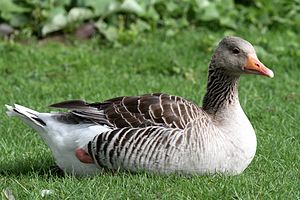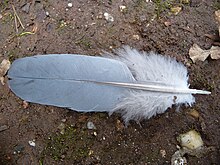Geese
| Geese | ||||||||||
|---|---|---|---|---|---|---|---|---|---|---|

Greylag goose ( anser anser ) |
||||||||||
| Systematics | ||||||||||
|
||||||||||
| Scientific name | ||||||||||
| Anserinae | ||||||||||
| Vigors , 1825 |
The geese (Anserinae) are a subfamily of the duck birds in the biological systematics of birds .
Surname
The term goose for this group of birds is relatively old. The term gans was already used in Old High German and Middle High German . Comparative analyzes with other Indo-European languages suggest that both the German name gans and the Latin name anser , which is now the generic name for field geese , are derived from the sound of the hissing geese.
In the German language, there are the terms Gänserich, Ganser, Ganterich or Ganter for the male goose , and the young goose or the goose chick Gänsel or Gössel (for more details, see the names of domestic goose and names for domestic and wild animals ).
distribution
In Central Europe , the gray goose ( Anser anser ) is native, from which the domestic geese have developed through domestication . The originally non-indigenous Canada goose ( Branta canadensis ) has established itself as a neozoon and now also breeds here regularly. The mute swan ( Cygnus olor ) was not originally native to Central Europe and was only introduced as a park bird in the 16th century.
The swan goose ( Anser cygnoides ) was domesticated in East Asia, and the cultivated form is called the humped goose . It has now been crossed with European domestic goose breeds.
The geese's main distribution area is in the Arctic , where most species breed. In the biocenosis of the Arctic and Sub-Arctic, geese play an important role as the main consumer of vegetable food. They even cause a change in the plant community and the surface structure. Their winter quarters are in the temperate zone, so that they cover great distances on the train . The regional migratory and resting activities vary depending on the weather in the winter half-year. The availability of suitable and undisturbed sleeping places as well as the food supply in the vicinity of the sleeping places also have an influence on whether and in how large numbers of geese are in an area. One of the noticeable behaviors at the resting and wintering areas is a pronounced daily rhythm. The resting and hibernating geese spend the night together on a certain body of water and look for their food in groups of different sizes on areas in the vicinity of the sleeping body. Geese use food areas that are between five and 10 kilometers away from the sleeping water. During the autumn migration, however, geese also seek out foraging areas that are much further away and can be found, for example, on harvested corn and sugar beet fields that are up to 30 kilometers away from the sleeping area. The geese leave the roost as soon as a certain brightness is reached. Morning departure may therefore be delayed in fog and rain.
In addition to these northern species, there are also tropical species and those living in the southern hemisphere, for example the Hawaiian goose and the black swan .
Way of life
Compared to many ducks, geese have little to no sexual dimorphism . They are usually larger and longer necked than ducks. The geese eat mostly vegetable foods. Swans usually feed by searching the bottom of the water for aquatic plants, while real geese eat grass and seeds on the land. The young of the real geese, on the other hand, are insectivores.
Geese are monogamous for life . With swans and the hen goose, the male is also responsible for building the nest, with the real geese this task as well as breeding is done by the female alone. The black swan is the only goose in which the male also participates in the breeding business and even has a brood spot .
Systematics


While every long-necked duck bird is often referred to as a goose in general terms, biologically the whistling geese , which have primeval characteristics, and the crack-footed goose, as well as the half- geese standing between geese and ducks, do not belong to this group. In contrast, the swans are clearly representatives of the geese.
To the subfamily geese (Anserinae) of the duck birds (Anatidae), in addition to the real geese and the swans , the deviating hen goose can be placed as a third recent , monotypical tribe. The real geese can be divided into field geese and sea geese . The former have a gray-brown basic color, the latter are mostly patterned in black and white. In addition, the extinct Moa Nalos of the Hawaiian Islands may be representatives of the geese.
The following species belong to the geese subfamily:
- Tribe swans (Cygnini)
- Genus Coscoroba
- Coscoroba Swan , Coscoroba coscoroba
- Genus Cygnus
- Black Swan , Cygnus atratus
- Black-necked swan , Cygnus melanocoryphus
- Mute swan , Cygnus olor
- Trumpeter Swan , Cygnus buccinator
- Whistling Swan , Cygnus columbianus
- Dwarf swan , Cygnus bewickii (sometimes placed as a subspecies of the whistling swan)
- Whooper swan , Cygnus cygnus
- Genus Coscoroba
- Tribe chicken geese (Cereopsini)
- Genus chicken geese Cereopsis
- Cape Barren Goose , Cereopsis novaehollandiae
- Genus chicken geese Cereopsis
- Tribe real geese (Anserini)
- Genus field geese , Anser
- Swan Goose , Anser cygnoid (sometimes in genus Cygnopsis )
- Bean goose , Anser fabalis
- Short-billed goose , Anser brachyrhynchus
- Greylag goose , Anser anser
- White-fronted goose , Anser albifrons
- Little goose , Anser erythropus
- Strip goose , Anser indicus (genus sometimes in Eulabeia )
- Emperor Goose , Anser canagicus (sometimes in genus Chen )
- Snow goose , Anser caerulescens (sometimes in genus Chen )
- Little snow goose , Anser rossii (sometimes in genus Chen )
- Genus sea geese , Branta
- Canada goose , Branta canadensis
- Little Canada Goose , Branta hutchinsi
- Hawaiigans , Branta sandvicensis (sometimes in its own genus Nesochen )
- Brent Goose , Branta bernicla
- Barnacle Goose , Branta leucopsis
- Red-necked Goose , Branta ruficollis
- Genus field geese , Anser
The goose in literature

- Joseph Victor von Scheffel : The Martinsgans . In: Gaudeamus! Songs from the narrower and wider , 22nd edition, Verlag Adolf Bonz & Comp., Stuttgart 1876
- Kate Douglas Wiggin: Diary of a goose girl. 1902.
- Mother Goose ( French Ma Mère l'Oye, German mother goose): literary figure from nursery rhymes and fairy tales , which is particularly widespread in America and Great Britain. In book illustrations she is usually shown as an older farmer's wife with a high pointed hat, or alternatively as a goose with a cap. Mother Goose rhymes (Mother Goose rhymes) are a generic name for poems that are addressed to children as humorous verses, counting rhymes or lullabies, have a simple meter and some have been passed on orally.
- Selma Lagerlöf : The wonderful journey of little Nils Holgersson with the wild geese , 1906, German 1907
- Grimm's Fairy Tale : The Goose Girl
literature
- Janet Kear (Ed.): Ducks, Geese and Swans. Oxford University Press, Oxford 2005, ISBN 0-19-854645-9 .
- Josep del Hoyo (ed.) Et al: Ostrich to Ducks. Lynx Edicions, Barcelona 1992, ISBN 84-87334-10-5 . (Handbook of the Birds of the World 1).
- SM Uspenski: Die Wildgänse Nordeurasiens , Westarp Wissenschaften-Verlagsgesellschaft, Hohenwarsleben 2003, reprint of the 1st edition from 1965, ISBN 3-89432-756-1 .
Web links
- Wild geese on the Lower Rhine
- NaturForum Bislicher Insel on the Lower Rhine near Xanten : Winter quarters for up to 25,000 Arctic geese - www.metropoleruhr.de
Individual evidence
- ↑ Viktor Wember: The names of the birds in Europe - meaning of the German and scientific names , Aula-Verlag, Wiebelsheim 2007, ISBN 978-3-89104-709-5 , p. 79
- ↑ Saxon State Office for Environment and Geology (ed.): Wild geese and swans in Saxony - occurrence, behavior and management , Dresden 2006, publication as part of the public relations work of the Saxon State Office for Environment and Geology, p. 23


